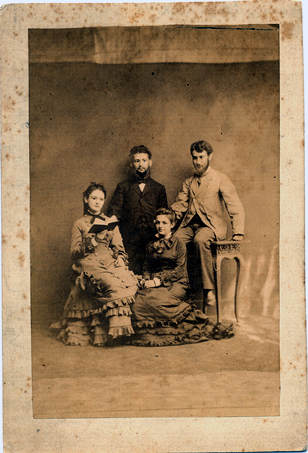Max von Portheim –-
Scholar, Bibliographer, Bibliophile
by Peter R. Frank (2004)
Max Porges von Portheim, descendant
of an old Jewish family in Prague, placed his considerable
fortune on the line by putting money into risky investments.
Eventually, so the story goes –- his lawyer cautioned
him.
“- Herr von Portheim, one
more transaction like that, and you are a ruined man!
You better keep your hands off things like that.”
„- All right, all right”;
sighed Portheim, “you are absolutely right. But
what can I do to keep myself busy?”
„- Well, you might collect
something, the lawyer suggested.
“- But what on earth should
I collect?”, Portheim asked.
The lawyer said the first thing
that came to his mind: ”
Well, how about collecting Josephinica?”
From that day on, the life of Max
von Portheim was dedicated to the Josephinian era.
Max von Portheim was
born in Prague on May 12th, 1857, as the son of the wealthy
industrialist Wilhelm Porges von Portheim and his wife Bertha
Goldsmith.
Both families traced their ancestry back to Jechiel Mechel
Spira and Glückel von Hameln. Portheim's grandfather,
Leopold Juda Porges, owned large cotton factories in Prague
and Smichow.
For his contribution toward establishing the textile industry
in Bohemia and his humanitarian activities he was, together
with his brother Moses, ennobled by Emperor Ferdinand I
in 1841.
Henceforth the family bore the name Porges Edle von Portheim.
After graduating from
secondary school (Gymnasium), Max von Portheim studied chemistry,
agriculture and later on philosophy and history at the universities
of Prague and Halle, without completing his studies with
a degree.
He travelled throughout Europe, especially Eastern and Southern
Europe, to broaden his mind and increase his knowledge.
There his language abilities came in useful in addition
to the classical languages, he mastered English, French,
Italian, Czech, Hungarian, Dutch and Flemish.
In 1893 he moved to Vienna, where he started to develop
his collections, something for which he sacrificed a large
part of his wealth.
Portheim's life-work was devoted predominantly to the Josephinian
era and the figure of Emperor Joseph II, whom he idolized.
Soon the times of Maria Theresia, Leopold II and Franz I
were also included in his project.
Thus, a thematically complete collection pertaining to this
era developed, the likes of which were to be found in no
other Austrian library.
In 1914 Portheim bought a mansion in Gatterburggasse 7 in
Vienna's 19th district, where a large library hall provided
ample room for his collections.
Modest in his personal habits, Portheim was surrounded by
a small circle of friends, among them his erstwhile collaborator
Gustav Gugitz (who in the years 1947-1962 published the
comprehensive Bibliographieund Stadtkunde von Wien
in five volumes), the folksong-researcher and cultural historian
Emil Karl Blümmel and Michael Holzmann (whose standard
work Deutsches Anonymenlexikon, published together
with Hans Bohatta, owes many of its references to Portheim's
catalogue).
But after the outbreak of World War I, his grand project,
an Austrian “"Goedecke", fell victim to
the adversities of the time.
After the end of the war, a large part of Portheim's wealth
was lost.
He was forced to give up further acquisitions and from then
on devoted his time and energy to the entries in his catalogue.
Max von Portheim died in Vienna on January 28, 1937 at the
age of 79.
The liberal and humanitarian
features of Joseph II's reforms may have appealed to Portheim:
The Tolerance Edict which proclaimed freedom of religion
as well as freedom of trade for Jews (who even under Maria
Theresia were expelled from Prague), furthermore the abolition
of bondage, (for which the Habsburg was beloved even in
Bohemia), restrictions on the privileges of the aristocracy
and the easing of censorship.
The emperor had even permitted the performance of Mozart's
operas with topics as contentious as in Figaro
or Cosi fan tutte.
After the French Revolution and the Jacobin trials the conservative
forces in Austria again won the upper hand, and the Catholic
Church was able to regain its influence.
They were suspicious and wary of Josephinian reforms which
they considered dangerous.
So for decades the memory of the Josephinian interval was
suppressed.
Unpurturbed by the tendencies of his time and totally on
his own, Max von Portheim ventured into this no man's land
and secured its survival and a fair appreciation in his
collection.
The most detailed
description of the catalogues can be found in the internet
(www.stadtbibliothek.wien.at/),
based on Gerda Barth's survey.
At the time of Portheim's death, his book collection contained
about 20,000 volumes, which, together with the catalogue,
was acquired in 1937 almost in its entirety by the Stadt-
und Landesbibliothek, Vienna.
To these were added 8,000 copper engravings (now together
with the catalogue in the Vienna Museum), with maps, views
and plans of the city.
The catalogues, handwritten
by Portheim with references to dates and sources include
the nominal catalogue in 74 boxes (now on 443 microfiches
with approx. 311,700 photos by Microform Gaul, Vienna 1987)
and the book catalogue in 12 boxes.
Others include the subject catalogue (with subjects ranging
from Anabaptists, book trade, celibacy, censorship, deists,
freemasons, gypsies and Jews to superstition).
There were also stage plays and calendars, a personal catalogue
of German royalty, of the Jews in Austria and a list of
the books from someone else's collection which Portheim
had read.
What is unusual is the fact that Portheim also registered
entries in newspapers and periodicals, things which were
otherwise mostly neglected.
Among his contemporaries,
Max von Portheim with his collections and catalogues was
regarded as the leading expert on the Josephinian era.
Indeed the first biographer of Joseph II, Paul von Mitrofanov,
sought his advice and used his sources, as did Constant
von Wurzbach and Joachim Kirchner (for his Bibliographie
der Zeitschriften des deutschen Sprachraums).
After 1945 other scholars, among them Leslie Bodi, Derek
Beales, Walter Grab and Ernst Wangermann were to make use
of Portheim's catalogue.
Only more recent research
has revealed the explosive nature of the Portheim Collection.
In the Josephinian brochures, which were condemned and despised
as trivia, Leslie Bodi found that some of them contained
not only crude banalities, but also the subversive irony
and sharp-tongued criticism which henceforth was to characterize
Austrian literature up to Karl Kraus and Helmut Qualtinger.
The book researcher Reinhard Wittmann characterized this
flood of brochures during the “"Tauwetter"”("Thaw"�)
as “"a flood of belletristic and political, diurnal
writings scarcely examined and especially those critical
of religion, this was absolutely unique in the history of
German literature. Even in Leipzig and Berlin up to 1948,
nothing comparable has been published in the way of radically
enlightened urban literature."
The Enlightenment from above, from the emperor, was answered
promptly by an echo from below in Vienna and, to a lesser
extent in Prague, which became continuously more and more
critical –- a unique situation in the realm of German
language.
The first signs of a democratic consciousness of the middle
class became apparent, touching not only a small circle
of intellectuals, but also a broad cross-section of the
population in the capital.
Rarely has a collection
such as that of Max von Portheim had such lasting influence.
Anyone wanting to trace the roots of democracy, of tolerance,
of the prevailing struggle between enlightenment and counter-enlightenment
in Central Europe up to the present day cannot ignore the
lifework of Max von Portheim.
Peter R. Frank
Translated by Anne
Ruth Frank-Strauss.
The original German text was published in the Mitteilungen
der Gesellschaft für Buchforschung in Österreich,
issue 2004/1 in Vienna.
Notes :
There are two larger studies available about Max von Portheim,
one by Leopold Tatzer, “Max von Portheim Bibliograph
einer Epoche” (in Kultur.Notizen, supplement
to Nr. 16, 1969), and the other by Gerda Barth, “Der
Portheim-Katalog der Wiener Stadt- und Landesbibliothek”
(unprinted, available in the WStLB in Vienna). Both studies
provided valuable material for this portrait. –Genealogical
evidence relating to the Porges von Portheim family was
furnished by Hanns Jäger von Sunstenau, Stammliste
der Familie Porges von Portheim (typescript, unprinted).
Clara Schlichtenberger offers an overview of the Goldschmidt
and Porges families in Die Ordnung der Welt. Die Sammlungs-Grammatik
Victor Goldschmidts, des Gründers der völkerkundlichen
Sammlung der von Portheim-Stiftung in Heidelberg (Pfaffenweiler:
Centaurus, 1998, S. 235-237).
In 1967/1968 the Stanford
University Libraries in California acquired the duplicates
of the Portheim Collection, which included many Josephinian
brochures, newspapers and periodicals. The library also
purchased the microfiches of the catalogue. All these acquisitions
were to serve as the foundation of a comprehensive Austriaca
collection at Stanford.
Die Luft
der Freiheit weht: German Topics and Holdings at Stanford,
from 1891 to 1974 .
by Peter R.
Frank, former curator (1967-1990) of Germanic Collections
at Stanford.
From Festschrift
for Elmer Grieder, Stanford, 1974. Abridged version.
Summing up the first
ten years of the Stanford University, President David Starr
Jordan wrote to Mrs. Stanford in March 1902: "...We
have the best college work in the world, even though we
do not have very much else. We do a real university work,
in the German sense, and more will come in time..."
University work in the German sense - with Graduate Studies
and seminars, and a specific "Wissenschaftsgeist"
both in Humanities and Sciences this still ultimate goal
for many American universities. Between 1820 and 1920 -
after G. Ticknor, E. Everett, J. Cogswell and G. Bancroft
arrived in Göttingen - at least 9,000 Americans studied
at such German universities as Göttingen, Berlin, Leipzig,
Halle and Heidelberg. German universities were considered
"model institutions." It was what later, has been
called the "German century" of American Higher
Education. Although the foundation of the Stanford University
was a special case, the impact of the "German Century"
was evident heard in the West, too. President Jordan, by
no means uncritical of Germany and German attitudes, was
impressed, as were so many of his American contemporaries,
by the success of German scholarship and scientific methods.
And obviously he knew German literature well. His very first
"works," published in the student weekly Cornell
Era were English translations of poems by Voss, Gleim, Schubart,
Schlegel, Goethe and Heine (the Loreley). Another
connection with Central Europe was the Peace Movement, for
which Jordan was a pacemaker in America. He appreciated
and supported the efforts of the Austrian Countess Bertha
von Suttner, and Alfred H. Fried, both winners of the Nobel
Peace Prize. (The Alfred H. Fried Collection came to Stanford
in the late 1920's and is now kept, together with the relevant
Jordan papers, in the Hoover Institution).
The unique use of
a motto in German on the presidential seal of an American
university, Stanford University, was the result of Mr. Jordan's
admiration for Ulrich von Hutten, a German Knight-Errant
and Humanist at the turn of the 15th century. As early as
1886, Mr. Jordan had written an article on Ulrich von Hutten
in The Current, and there he used the German translation
by D. F. Strauss of an original Latin sentence: "Die
Luft der Freiheit weht" (which means: The winds of
freedom are blowing), which later became the motto. One
even can find it now on such university forms as budget
accounts.
Of some thirty full
and associate professors of the first Stanford faculty,
half of them had studied in Germany, among them the German-born
E. Flugel, later Head of the English Department, an eminent
Chaucer-scholar, co-editor of Anglia and founder
of its Beihefte, Professor Matzke, Head of the
Romance Languages Department, and Professor Angell, head
of the Psychology Department, and a student of U. Wundt.
Andrew Dickson White, the famous historian, who later became
minister and then Ambassador to Germany, once gave lectures
on European History at Stanford. When a professor of philosophy
was to be appointed, Mrs. Stanford simply recommended acquiring
one of first reputation from Germany, "as I learn Harvard
has done."
Under these circumstances,
it is not surprising that there has been a broad and lively
interest in German topics at Stanford from the very beginning.
Since statistics for area studies in such fields as Art,
Music, History, Philosophy and others are not easily available,
the enrollment in the German Department may serve as a general
indicator. Starting with 11 majors in the first academic
year 1891-92, the figure rose to 55 in 1896, and reached
the peak with 101 majors (and About 650 students attending
courses in the department) in 1905-06. The first low point
came in the aftermath of World War I, in 1923-24, with 5
majors (but 862 students attending courses), surpassed with
only 2 majors in 1944-45. In 1967-68 a new high was reached
with 89 majors, a figure which has dropped again. But still
about 600 students attend courses in German Studies year
after year.
As illustrative as
these figures might be, they reflect what the faculty had
to offer and what attracted the students. In the first academic
years, from 1891-92 on, the students had ample opportunity
to become acquainted with a variety of "German"
topics. In Education, for example, Professor E. Barnes (Ph.D.
Zurich) undertook a comparative study of European school
systems (among them Germany and Switzerland), he gave courses
on Rousseau and Pestalozzi and Herbartian Pedagogy.
A lecture on Kant
was given, which became a standard up to today, whereas
Hegel had to wait until 1931-32, to be treated extensively
in a seminar. In 1900-01, Professor A. E. Lovejoy lectured
about German philosophy since Kant, and William James based
his General Introduction to Philosophy in 1904-05 on Paulsen's
Introduction. In psychology, Professor Angell required
Ziehen's and Wundt's works for his courses, and for most
seminars the knowledge of German was compulsory. It was
not until 1924-25, however, that Professor C. P. Stone gave
his courses on Freudian psychology, which were
repeated regularly until the forties. In Economics and
social sciences, Professor E. A. Ross dealt in his
lecture on pure economics with Menger and Böhm-Bawerk,
the Austrian marginal utility school; in statistical sociology
with Schäffle and Gumplovicz. In his lecture on socialism
he treated French and German socialism. Listed third after
the classical languages, Greek and Latin, the German Department
in the first academic year offered 11 courses and seminars
(in 1973-74, about 100 courses were announced in German
Studies). Although the early faculty did not have many internationally
known, "brilliant" Germanists, it had inspiring
teachers such as J. Goebel (1891-1905 at Stanford). Goebel
lectured on Goethe and his era, and many other topics. He
was also interested in German-American matters. (This topic
came up again in 1929-30 by a course given by C. v. Klenze,
German influences on American cultures, and again in my
seminars on Stereotypes and prejudices, "the"
Germans and "the" Americans. in 1971 and
1973.) The Department showed great flexibility in the thirties,
with the Professors B. Q. Morgan and K. Reinhardt and the
then instructors, W. Strothmann and A. E. Sokol, teaching
not only regular courses about Germany, the country and
its people, but also about Austria and Switzerland. This
work was the first indication of a German Studies program.
In 1922, B. Q. Morgan's standard work A Critical Bibliography
of German Literature in English was published by the
Stanford University Press (a second enlarged and revised
edition was published in 1938). Professor Morgan also started
courses about the Art of Translation a forerunner of the
Program of Translation and Interpretation in German Studies.
Naturally, B. Q. Morgan encouraged the library to collect
German texts in English translation - thus the extensive
holdings in this area. Beginning in 1934-35, there was also
some emphasis on Austrian literature (with lectures by Professor
Sokol and Professor Arnold). About that time Professor Reinhardt
introduced courses in Scandinavian languages and literature.
The History Department
was involved in teaching and research of German and Central
European History from the beginning. This emphasis was reinforced
by the foundation of the Hoover Institution in 1919, which
contains the second largest collection of contemporary material
- aside from the Library of Congress.
The numbers of guest
lecturers from German universities from 1891 to 1914 is
impressive. After World War I, more famous scholars came
to Stanford as visiting professors: from 1925 to 1929 the
Austrian historian A. F. Pribam, then J. Redlich (Political
Science) and finally Moritz Schlick, the philosopher from
the Vienna Circle. From 1928 on, the German literary historian,
F. von der Leyen, taught twice at Stanford, followed by
J. Petersen, R. F. Arnold and A. Closs. During World War
II and afterwards, the emigrees K. Vietor, the philosopher
M. Geiger, the eminent psychologist K. Lewin, the economist
F. A. Hayek and the historian H. Holborn were visiting professors
at Stanford.
Several prominent
members of the Stanford faculty came from Central Europe:
in 1933, Felix Bloch, the physicist and Nobel Prize winner,
later Hermann Fraenkel, the well-known classical scholar,
and after World War II, Lorenz Eitner, Head of the Art Department,
to name only a few. Thus, connections with Central Europe
and Smith Germany were not a distant affair, but a lively
experience. The possibility for Stanford undergraduates
(since 1963-64) to spend some time in the new Overseas Campuses,
at Stanford-in-Germany near Stuttgart, at Stanford-in-Austria
in Vienna, and for graduates to participate in programs
first in Hamburg, then in Bonn/Köln and now also in
West-Berlin opened new channels for an encounter with Central
European history culture and ways of life.
It is in this context
that the German holdings at Stanford University Libraries
have to be seen. It began with a coup: in 1895, at a time
when Stanford was in a financial crisis and almost no money
was available for the library, the private library of the
late Professor Rudolf Hildebrand, Leipzig, was acquired
for $5,500. Considering the time and the circumstances of
this acquisition, it was an enormous amount of money for
Stanford to come up with. It was the largest single collection
purchased by the library up to this time, and it still is
one of the largest purchases ever made by Stanford.
There was also a comic
interlude when those librarians concerned with the Hildebrand
acquisition wisely avoided to consult Mrs. Stanford. Aside
from the faculty, where almost all members pledged to contribute,
they tried to solicit money from the trustees and Mrs. Stanford's
personal friends. When Mrs. Stanford learned about this
matter, she furiously cabled to President Jordan: "...I
cannot consent to purchase that German library..."
But fortunately it was too late, and the 4,605 volumes and
1,052 pamphlets were purchased, or, how it was soon disguised:
presented as a "gift" to the library. The unpaid
remnant of the money was raised as late as November 1897,
at a Kirmes, where Mrs. Jordan, wife of the president, and
Mr. Nash, the librarian, directed and participated in a
farce, "The Train Robber." Professor
Goebel's good offices were instrumental in acquiring the
Hildebrand Collection for Stanford. However, when the Collection
arrived, he seemed to consider at least parts of it as his
private library and kept it in his house. When he had to
leave Stanford in 1905, some carloads were needed to bring
these books, long overdue, back to the library.
With the acquisition
of the Hildebrand Collection, Stanford had a solid foundation
of books mainly in the field of German literature and languages.
Since Hildebrand was co-editor of the famous Grimm's Deutsches
Wörterbuch, his library was a true "Gelehrtenbibliothek."
It contained not only many rare and sought after items,
books and periodicals from the Reformation and Baroque Period,
but also editions of the German Classics up to the end of
the 19th century, and a wealth of secondary literature.
Concluding from the
Accession-Books and the Reports of the Librarian, the holdings
in German History were limited for some time to a few standard
works, mostly in English, such as Carlyle's History of Frederick
the Great (acquired in 1891, when Mommsen's History of Rome
was also bought). Dahlmann-Waitz was bought in 1895, and
the Monumenta Germaniae Historica in 1899/1900. But faculty
and graduate students had access to the rich holdings and
treasures of the Sutro Library, San Francisco,and since
Adolph Sutro was German born, European and Central European
history was well represented in his library.
The impact of German
Science can be heavily felt up to World War II and still
thereafter, when again and again large sets and periodicals
such as the Journal fur praktische Chemie, the Mathematische
Annalen (purchased 1898-99), die Fortschritte der Physik
(purchased 1906-07), or the 69 vols. of Palaeontographica
were listed among or as the most important acquisitions.
Thus, Stanford also has an excellent collection of German
periodicals and sets in the field of science.
How close the ties
between Stanford and Germany were may be illustrated by
another example. In 1910, the Lane Medical Library was incorporated
in the Stanford Library System. Professor Adolph Barkan,
born in the Austro-Hungarian monarchy, who had studied at
the University of Vienna and later joined the faculty of
the Medical School, inaugurated and promoted there the Library
of the History of Medicine, which became one of the finest
collections of its kind. In 1922, Professor Barkan acquired
the private collection of Professor Ernst Seidel of Meissen,
who wanted to build a hospital with the proceeds to help
the blind German veterans from World War I. Thus a famous
collection of early manuscripts and books, mainly of Oriental
origin, came to Stanford. And Professor Barkan was successful
in interesting Professor K. F. J. Sudhoff, Leipzig, founder
of the modern scientific history of medicine and truly the
first man in this field, to advise Stanford in further acquisitions.
For years , a full card catalog of the Stanford Collection
on the History of Medicine was kept not only here but also
in Leipzig, and additional acquisitions were made by Professor
Sudhoff and his successor, Professor Riekbiehl.
When the Hoover Library
on War (now: Hoover Institution on War, Revolution and Peace)
was founded in 1919, one of the most important research
institutions for contemporary history became part of Stanford.
Collecting material covering Central Europe mainly from
1471 on, the library contains, aside from the main stock
of books, many ephemera such as posters and broadsheets,
secret government material, manuscripts (e.g. the original
diaries of J. Goebbels and H. Himmler), a wealth of German
regional newspapers, aside from such collections ad the
A. Fried Collection, the library of K. Kautsky, the Thompson
Collection and others. This material, together with the
holdings of the University Library, gives Stanford an unusual
strength in the field of modern and recent Central European
history.
Whereas the treasures
of the Hoover Institution are recognized internationally,
other treasures at Stanford, which reflect major aspects
of the German cultural heritage, are regrettably unknown
even at Stanford itself. For example, the Memorial Library
of Music in the Special Collections and the Archive of Recorded
Sound, with about 100,000 records and tapes comprise one
of the five large collections in this field in this country.
The Memorial Library of Music, part of the libraries' Special
Collections, was established in the memory of the American
soldiers who died in World War II. It contains, for example,
the autographs of one of the earliest Bach Suites, Beethoven's
In Questa Tomba Oscura, Brahms' Tragic Ouverture,
Schubert's Lied in Grünen and the famous Rosamunden-Ouverture
and Johann Strauss' Eine Nacht in Venedig, to mention
only a few. The Archive, on the other hand, has a wealth
of early recordings, with famous performances of German
conductors, instrumental soloists and singers. There is
also a tape with the voice of Franz Joseph I, his opening
remarks for an exhibition, and, on the darker sides records
of speeches of Hitler. Both the records and the manuscripts
supplement the holdings of an excellent Music Library.
How important German
Studies were considered to be here at Stanford, can be traced
back to the appropriations for books in the years 1907-08
to 1910-11, where German material ranked fourth and fifth
(among 29 fields, after general Literature, History and
English Lit erature and Philology). This ratio might even
look better if one considers, that many works in General
Literature and History came from Germans.
And a recent study
about books cataloged in 1971 at Stanford University Libraries
found the following figures: books in German language ranking
third with 13% after books in English (50.8%) and books
in Spanish and Portuguese (together 14%); after place of
publication, Germany, Austria and Switzerland ranking second
(with 13.6%) after the United States (37.6%) and before
Latin America (12.5%), the United Kingdom (9.2g), France
(6.9%), Eastern Europe (5.8%), USSR (3.5%)and several other
countries. At that time, this percentage reflected also
roughly the ranking in books ordered by the Stanford University
Libraries.
In less than sixty
years after its foundation, the Stanford University Library
had grown to be a noteworthy academic library, with some
fine and even outstanding collections. But at the end of
World Star II the overall picture was not bright. The holdings
were grossly unequal, extensive in some areas, in others
simply neglected with she most awkward gaps and lacunae.
Although German history of the 19th century was a favorite
topic at Stanford, it was not until 1968, for example, that
the Collected Works of J. v. Miller, Clausewitz or Ranke,
the important collection of letters by H. A. Treitschke
were purchased. It was obvious that the acquisition policy
was outdated and inadequate in many respects.
The gap between the
demands of the faculty and the actual holdings of the library
became especially heavily felt when the university grew
rather rapidly after World War II. In 1971, Professor G.
H. Knoles, then Chairman of the Department of History, could
state: "His (Professor P. Paret's) coming made it possible
for us to offer a continuous series of courses in German
history from the Reformation with Lew Spitz to the 20th
century with Gordon Craig. This probably makes our department
the strongest in the country in the field of German history..."
The German Department changed from the combined Modern European
Languages to German Languages and Literature, and finally
to German Studies, formally adopting new or revived programs
such as Deutsche Geistesgeschichte and a program in translation
and interpretation.
Other departments
and programs, newly established, such as Comparative Literature,
Humanities Special Program and Religious Studies, Linguistics,
Art, and the new interdisciplinary Medieval Studies Program
(to list only a few), they all posed special demands on
German material. And there were professors with specific
research interests, Professors Boehninger and J. Flores
in the literature of the German Democratic Republic, Professors
W. H. Sokel and, E. Lohner in German Expressionism, P. Paret
in European Military History, L. W. Spitz in Renaissance
and Reformation, H. Weiler and Peter Foulkes in reforms
in higher education, expecting that "their" areas
had to be covered well by the library. In the early sixties
Professors G. Craig, W. Vucinich and G. Wright from the
History Department administered surveys of library needs
(and holdings) in the area of Central Europe, thus breaking
the ground for the necessary change in the acquisition policy.
The result of this survey was summed up in a statement by
Professor Gordon Craig in 1964:
"In History we
really are dependent on what is in the library. We don't
need machines or equipment; what we need most of all are
books and magazines and collections of local journals, satirical
magazines. In the field of history, we have [at Stanford]
a pretty fair selection of secondary materials, books. In
official papers and documents, we are in fair shape, but
there are astonishing holes. And in the level of scholarly
magazines, we have only the obvious, and not all of those.
The reasons for this are readily apparent. If you depend
on professors to work for your library, it will be spotty,
with good collections in the professor's specialty, and
nothing else. This problem can only be checked by having
an adequate staff and by spending a lot of money."
But a remedy was already
underway. As early as November 1946 a survey of library
resources and services was undertaken by Dr. Louis R. Wilson
and Dr. R. H. Swank, emphasizing the need for a systematic
program of collection development. In the 1950-51 Annual
Report of the Director of the Libraries, new concepts are
surfacing: "...We are now trying to vitalize the Unlversity
Library... First, the library should organize and coordinate
the selection of books...The collections should be organized
not only physically, but also bibliographically for effective
use... The professional library staff, augmented by an efficient
non-professional staff, should become bibliographic specialists
of high caliber. In their own right as librarians, they
should deserve to stand as colleagues with the faculty ..."
Since Mr. Grieder came to Stanford 1949-50, one may assume
that this statement already reflects his ideas.
Mr. Grieder finally
was instrumental in the creation and pursuit of a new book
selection agency in 1963, the Resources Development Program,
headed by him from the beginning. This Resources Development
Program was in itself a mixture of German and American traits,
namely the "Referentenwesen" (the topic-specialists
as they are known in German libraries),and the Area Studies
Program, significant at American universities. This Resources
Development Program started out at Stanford with three language
groups: Romance Languages (Dr. Paul Kann), Germanic Languages
(Gabor Erdelyi) and Slavic Languages (Peter Kudrik).
Four things worked
together for rapid and steady success: firstly, sufficient
funds; secondly, some highly cooperative and competent faculty
members; thirdly, the wave of reprints and again an ample
supply of out-of-print books; and last but not least, knowledgeable
curators and assistants - in the German field Gabor Erdelyi
(1963-65), Dr. Martin Wierschin (1966-67), Dr. Peter R.
Frank (1967 - ), and Mrs. Karen Apton, an assistant to these
curators, among others. Now an opportunity existed to screen
the material corresponding to the need of faculty and students,
and round up the holdings. The know-how and resourcefulness
of the curators and assistants have made it not only possible
to get long-wanted items, but to get many of them inexpensively.
This alone saved the library thousands of dollars over the
years.
One of the first projects
was to buy about 400 books by writers from the German Democratic
Republic (or East Germany, as it was called then), for a
course given by Professor H. Boehninger. In 1963, this topic
was still a rare bird in American universities. And in the
climate of the Cold War, it was a controversial matter too.
Funds were made available in Stuttgart, Germany, and the
books were purchased from Pinkus, a dealer in Zurich, Switzerland.
I arrived at Stanford
in October 1967 and vividly recall the hot sky of a California
fall. Only a few weeks later an outstanding Austrian Collection
was offered by Fritz Hailer of Berg near Munich. The collection
was to be sold in two installments, together about 3,000
volumes and 1,260 broadsheets and leaflets, for a total
of about $28,000. Since the "gift" of the Hildebrand
Collection in 1895, this was to be the Second large German
Collection bought by the Stanford University Library.
The collection consisted
mainly of duplicates from the famous Max von Portheim
Collection (now housed at the Vienna City Library). It was
especially strong in rare material of the period of Maria
Theresia and Joseph II., the A ustrian Enlightenment, but
also for the Wars of Liberation, the Revolution of 1848-49
and the "Gründerzeit." Included in this collection
were books from other sources, Th. v.Karajan, M. Grolig
and Archduke Rainer, among others. Although I had a fair
knowledge of the period, I was at that time by no means
an expert. However, I realized at once the great value and
importance of this Collection. After a preliminary discussion
with Rutherford D. Rogers, director of Libraries, and Mr.
Grieder, consultation with professors from the German and
History Departments (who highly recommended the purchase),
I telephoned Haller in the middle of the night, ascertained
that the library was still available, and secured it forStanford.
Within the next few days, no fewer than three other libraries
sent in their orders to Hailer.
When the books, periodicals,
pamphlets and broadsheets arrived in March and May 1968,
we unpacked them day after day. Most of them had the characteristic
book plate of Max von Portheim. We found
masses of "Broschüren-Literatur" of the Josephinian
era, elegant prints by Degen, the "Austrian Bodoni,"
and by Trattner, the noble pirate-printer; standard works
such as Die Österreichische Monarchie in Wort und
Bild as well as popular novels by E. Breier and A.
v. Sacher-Masoch; and books with the characteristic binding
of the "Historizismus" and the Austrian Art Nouveau.
At this point, I acutely felt the difference between a liar
of books being offered and the actual material at hand;
the menu - promising at best - versus a full, opulent dinner.
As with the Hildebrand
Collection in the German field, the Portheim Collection
gave Stanford at once one of the best Austriaca collections
in this country, with many items present only in this library.
(A large part of the collection is therefore kept in Special
Collections.) Since books, fortunately or unfortunately,
represent an investment that does not increase by interest
accrual, we tried to supplement this collection systematically
with source material and secondary literature. Despite some
recent research, the oscillating phenomenon of Josephinism
- with its religious and political struggles and reforms,
the rise of the bourgeoisie, a truly popular literature,
the music of Haydn and Mozart, and a classical and folk
theater - is still a challenge for interdisciplinary research.
Hopefully it will start at Stanford some day.
Another opportunity
came in 1973, with an offer from Kraus in Liechtenstein
of Swiss material. A quick search revealed that neither
Berkeley nor Stanford had even much elementary material,
such as the Eidgenössischen Abschiede...and similar
items. Since Berkeley, aside from its German Collection,
was traditionally interested in the Nordic area, it seemed
reasonable for Stanford to supplement its German and Austrian
collections with a Swiss "branch," in order to
have a well covered Central European collection. We bought
some 18 items (almost all of them multi-volume sets with
30 to 80 volumes) for about $7,000. It consists of complete
runs of documents, the major historical bibliographies,
periodicals and the important publications of regional and
local historical societies. As it had been done before with
the Federal Republic of Germany and with Austria (and, in
some respect with the German Democratic Republic), we immediately
established relationship with officials of the Swiss government
to secure government documents, the Bulletin from
the Swiss Embassy in Washington, the publications of Pro
Helvetia and other materials for the library.
Aside from these purchases
of larger collections, there were other buying opportunities.
On a trip to Volkoff & Hohenlohe of Pasadena, I found
rare theological, political and historical works from the
period of the Re formation and the Baroque, also a sizable
collection of about 3,000 Schulschriften, and long runs
of "Programme" from more than 200 German and Austrian
schools.- When Mr. Joseph Rubinstein moved from San Francisco
to Berkeley, he sold part of his stock. We were able to
acquire such periodicals as the Gundlingiana and
Meusel's Magazin in addition to a number of books
for quite a reasonable price. The most striking experience,
however, was a private "book sale" by the young
heiress of a Vienna-born architect. She asked me first to
assess the books. I offered to bring catalogs and the Jahrbuch
der Auktionspreise along in order to assure her that
the suggested prices were fair. Then she suddenly changed
her mind and insisted that a San Francisco book dealer should
make the estimates instead. After this was done she sold
some books to us, and I doubt that Stanford will ever get
titles such as Hohberg's Georgica Curiosa Aucta
or Abraham a Santa Clara's Reimb Dich... at a lower
price.
Since the start of
the Resources Development Program one of the most effective
ways of buying material for the library his been buying
trips of the curators in Europe, mostly in Central Europe.
Urgently needed items may never show up in a catalog since
antiquarian lists do not show the entire stock of a dealer.
Furthermore, more and more antiquarian dealers are disinclined
to answer "Search and Quote" requests. The various
buying trips (G. Erdelyi 1964-65, Peter R. Frank 1970 and
later, in connection with teaching appointments) turned
out to be most successful. A passage in the Annual Report
for 1965 of the Director of the Libraries may have surprised
many people at the library: "... this has been a most
profitable venture in more ways than one. Numerous titles
have been obtained that were considered unavailable. Prices
paid are significantly lower - not infrequently 50-80%...
Moreover, valuable and lasting relationships were established
withdealers, libraries, and other agencies that are essential
for this library in building up its collections."
The curators went
to Europe well prepared, thanks to the cooperation of the
assistants, part-time help of students and some departments
in preparing want lists. Standard bibliographies such as
G. Franz, Bücherkunde zur deutschen Geschichte,
the Marbacher list Deutsche Literatur vom Humanismus
bis zur Gegenwart or the Rock Austria-list
had been checked in advance. This preparation and the desiderata-lists
saved all involved dealers and institutions, curators and
assistants - considerable time and made the work so effective.
The question whether
Blanket Order plans are serving the best interests of a
library is much disputed again nowadays. Stanford entered
a Blanket Order/Approval Plan for material from the Federal
Republic of Germany, the German Democratic Republic, Austria
and Switzerland with Otto Harrassowitz in Wiesbaden in 1967,
and it has worked out fairly well. One of the great advantages
of this program is that the actual books can be inspected
and selected here at Stanford and can be sent back if we
don't want them. Together with the marked national bibliographies,
which Harrassowitz sends us beforehand, allowing additional
selections and ordering, we are sure to get a good coverage
for all recent material.
Although the curators
have to rely in many cases on the advice, suggestions and
help from both faculty members and students, there still
is always ample opportunity for their own initiative. Closely
observing the trend of research in Germanuniversities, and
also the trend of interests at Stanford, we developed over
the years what might be called an "anticipatory acquisition
policy."
Changes in German
Studies were very often implemented first in German speaking
coun tries, e.g., the change in literary studies from interpretation
to a sociological approach. It was foreseeable that these
changes would sooner or later have an impact on German Studies
in the United States. We acquired therefore at an early
date, when the material was still available and not too
expensive, numerous older books and of course the new publications
which were relevant to this kind of study. Another case
was the feminist movement in Central Europe, where hardly
anything was available at Stanford. We bought early journals
such as Die Frau or the Jahrbuch der Deutschen
Frauenvereine, but also the standard works by G. Bäumer
and Marianne Weber, and older material such, as Hippel's
or Brandes' treatises, works by women authors and biographies
of women.
This material is readily available for courses now given
atStanford. Still another example are Judaica, of interest
to Religious
Studies, History, Political Science and many other departments.
Compared with the original holdings, all these purchases
(and several others, e.g. in social and economic history)
have developed over the years to sizable and good collections.
But fortunately, not all books have to be bought. Many items
come in either by exchange (official and semi-official documents,
dissertations, and so on) or as gifts. The university seemed
to have established an exchange program with Central European
libraries from the beginning, because dissertations have
poured in for a long time. They had piled up in masses and
were shelved - still uncataloged - in the basement of the
new Meyer Undergraduate Library. In 1968, we finally started
to screen and sort this wealth of German dissertations (roughly
estimated about 80,000 to 100,000 items!), a task which
needed a full year, up to June 1969.The earliest dissertation,
properly in Classics, was from Leipzig, 1834.
Several of the dissertations turned out to be from later
famous scholars: from G. Hertz, M. Scheler, P. Tillich,
A. Weber, V. Valentin, H. Fraenkel, H. Zimmer, and others.
Some contained otherwise not available source material,
editions of texts or documents, and many of them were monographic
studies on authors and topics, where little else is available.
These dissertations, since cataloged, considerably strengthened
our apparatus of secondary literature in many areas.
Among the "German"
gifts within the last decade, the most notable were from
Professor G. E. Steinke, Henry von Witzleben, and through
the good services of the latter, the beautiful library of
the late Bruno Adriani, Carmel, mostly art books and French
editions, but also rare prints from the "George-Kreis."
Remarkable was also the gift by Mrs. Moore, in memory of
her parents, Wilhelm and Alice Weiss, of about 1,200 books,
300 of them for Special Collections. I still remember the
rainy, stormy day when I drove over to Berkeley to a house
at the foot of the hills. Mrs. Moore showed me the way to
the first floor and opened the door to a room of moderate
size. There was suddenly a touch of the Old World: Biedermeier
furniture, and on the shelves, in small octavo, the first
editions of Wieland, Goethe, Schiller and Jean Paul, among
others. When the library came to Stanford, I discovered
a copy of a letter in a book about the Silesian Armee-Abteilung
Woyrsch, where Mr. Weiss had served as an officer during
World War I. The letter, written in Amsterdam 1933 or 1934,
was sent to a comrade in arms, then a high ranking officer
in the new German army. It challenged the treatment of Jews,
many of whom had fought for their country. The silence of
the small library room with the editions of German classics,
now the copy of a noble, moving letter: German history of
the last decades, bewilderingly alive again.
A library is not simply
an institution which mechanically orders a nd buys books.
Many purchases, and certainly the expensive ones, are given
a great deal of consideration: do the faculty and the students
really need this work? Will it be used at Stanford? Could
it not be borrowed via interlibrary loan from the University
of California at Berkeley Library, or elsewhere? Is the
price justified? Although Stanford has the Faber du
Faur Baroque Collection on microfilm, we decided against
spending $15,000 for the microfilms of the Harold Jantz
Collection, since Berkeley purchased it. There was
the case of a collection of letters by R. F. Redlich (who
once taught at Stanford as visiting professor), which were
considered for a joint purchase of Stanford Libraries and
the Hoover Institution. Finally it was decided against it,
because it was felt that at that time the amount of money
was needed more urgently for other projects. And there were
occasions where we saved the library money rather unwillingly.
A sad example is the collection Deutsche Staats-und
Verfassungsgeschichte 1562-1860, parts of the library
Graf L. Thun-Hohenstein, Teschen, offered for about $11,000
by F. Hailer in 1968. The checking of the difficult material
and the consultation with the faculty took possible a few
days too long - alas, the library was sold when our cable
arrived.
"A library resembles
the ocean in that each contains hidden treasure" (G.
W. Nagel). As the ocean grows, it becomes more and pore
difficult to find these treasures. A case in point is the
Hildebrand Collection, which was first a special collection,
then was distributed to the proper classes and shelved among
other books. Proudly announced in the Annual Register
for a long period, then mentioned only with the German courses,
it finally disappeared from the lists altogether. Today
only a few insiders know about this important collection
at Stanford, and the catalog of the Hildebrand Collection
was not even listed in Down's American Library Resources.
Whereas the old concept of libraries, especially on the
European continent, was to collect books and keep them safe
for future generations (with the librarian often in the
role of a zealous bodyguard), a new concept sees the library
open and in a double role: not only acquiring books, but
also propagating the collections and facilitating the access
to them. Since curators and assistants have the best knowledge
of their respective collections, they are consulted regularly
by faculty members, students and outside visitors. To make
the collections better known not only at Stanford, but also
outside, a more aggressive approach seemed to be necessary
resulting in the publication of bibliographies, lists, articles,
bibliographical courses and exhibitions.
As a joint enterprise
of the Stanford University Libraries and the Hoover Institution,
G. Erdelyi and A. Peterson published, a very thorough checklist
of currently received serials, German Periodical Publications
(Stanford 1967). A revised second edition had been planned
by A. Peterson and Peter R. Frank to include also old material,
but it had to be postponed in favor of a first Union
List of Serials, published as a computer printout in
four volumes in 1974.
Important additions
to the German collection or older material, which had "disappeared"
in the "ocean of books," were presented in numerous
articles by Mr. Grieder and myself in the Stanford Library
Bulletin, articles dealt with the "Portheim
Collection" March 22 and May 3, 1968), German
Baroque Books (July 2, 1970),a new important reference tool
(November 10, 1972), and the acquisition of Swiss material
(February 9, 1974), among others. Since it has hardly been
recognized that Stanford also has an extraordinary collection
of German periodicals, with many old and rare items, I felt
compelled to report about this (February 6 and 20, 1970).
The Austriaca Collection has been described at greater length
in volume 4 of Austriaca-Americana (Wien 1974). A further
step was to inform both Mr. Ash and Mr. Downs about special
holdings and catalogs of German material at Stanford, in
order to have them included in further editions of Subject
Collections and American Library Resources. And since
1968, faculty members and students who are interested in
German materials were regularly informed by a Monthly List,
which contained a selection of newly arrived books. These
lists together with the Annual Report of the Curator documented
in great detail the activities and achievements of RDP-German
since 1963.
... As President Jordan
had predicted in his letter in March 1902 to Mrs. Stanford,
the Stanford University became, in less than 100 years,
in many fields a first ranking institution for higher education,
for teaching and research. The library, on the other hand,
was able to enlarge its holdings from one million volumes
after World War II to a stunning four million volumes in
the 70's. What is not so strikingly evident and cannot be
measured by these figures is the increase of quality of
this material. It is fair to say that German topics and
holdings were among the areas which profited most from this
growth. This development is due to the clear and far-sighted
concept of Collection Building, the creation of the Resources
Development Program under the direction of Elmer M. Grieder,
the hard work and the esprit du corps of all involved. Although
German is no longer in the "Ivy League" in Courses
and Degrees (as it was with Greek and Latin in 1891) and
has to share its place with numerous other departments including
many new ones, the interest of faculty and students in Central
European topics and questions, the interest in the results
of scientific and technological research done over there
is strong, as it has been traditionally at Stanford. We
can expect it will stay this way for years to come, as long
as Die Luft der Freiheit weht.
|
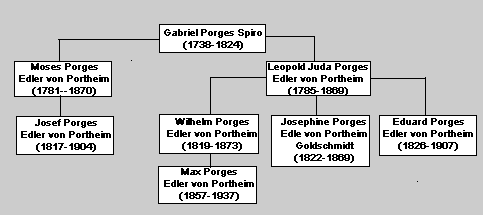
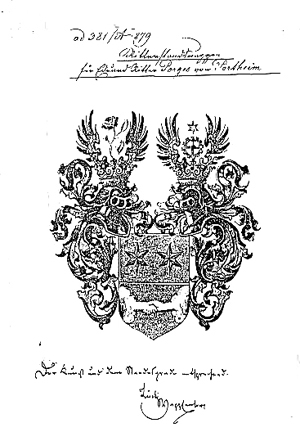
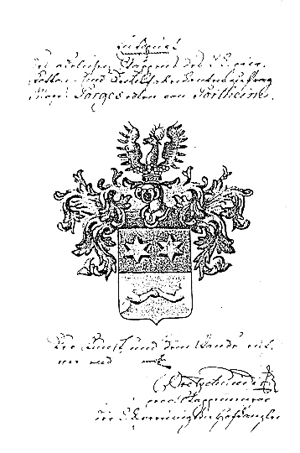
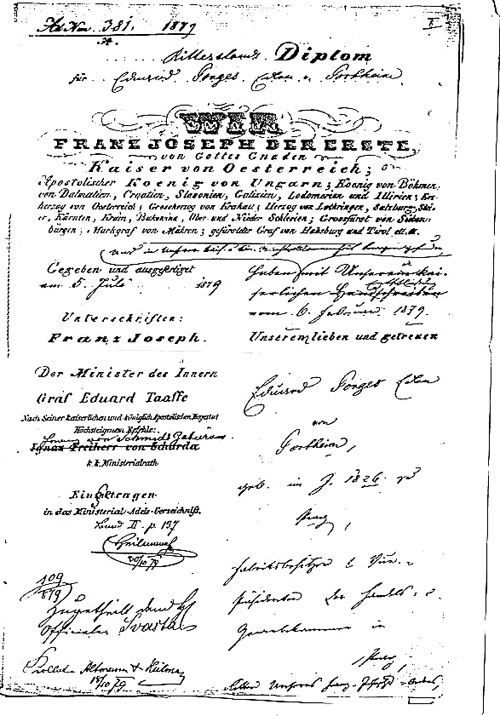
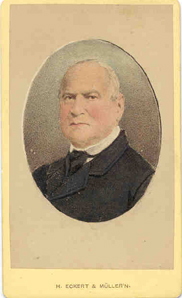
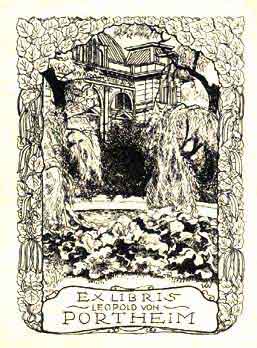
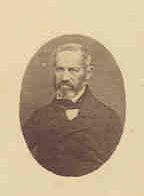
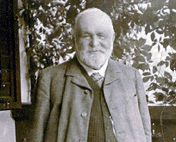 Eduard
Porges Edler von Portheim, son of Juda, vice-president of
the Chamber of Commerce of Prague. Was baptized and ennobled
to the Austrian nobility on July 5, 1879.
Eduard
Porges Edler von Portheim, son of Juda, vice-president of
the Chamber of Commerce of Prague. Was baptized and ennobled
to the Austrian nobility on July 5, 1879. 